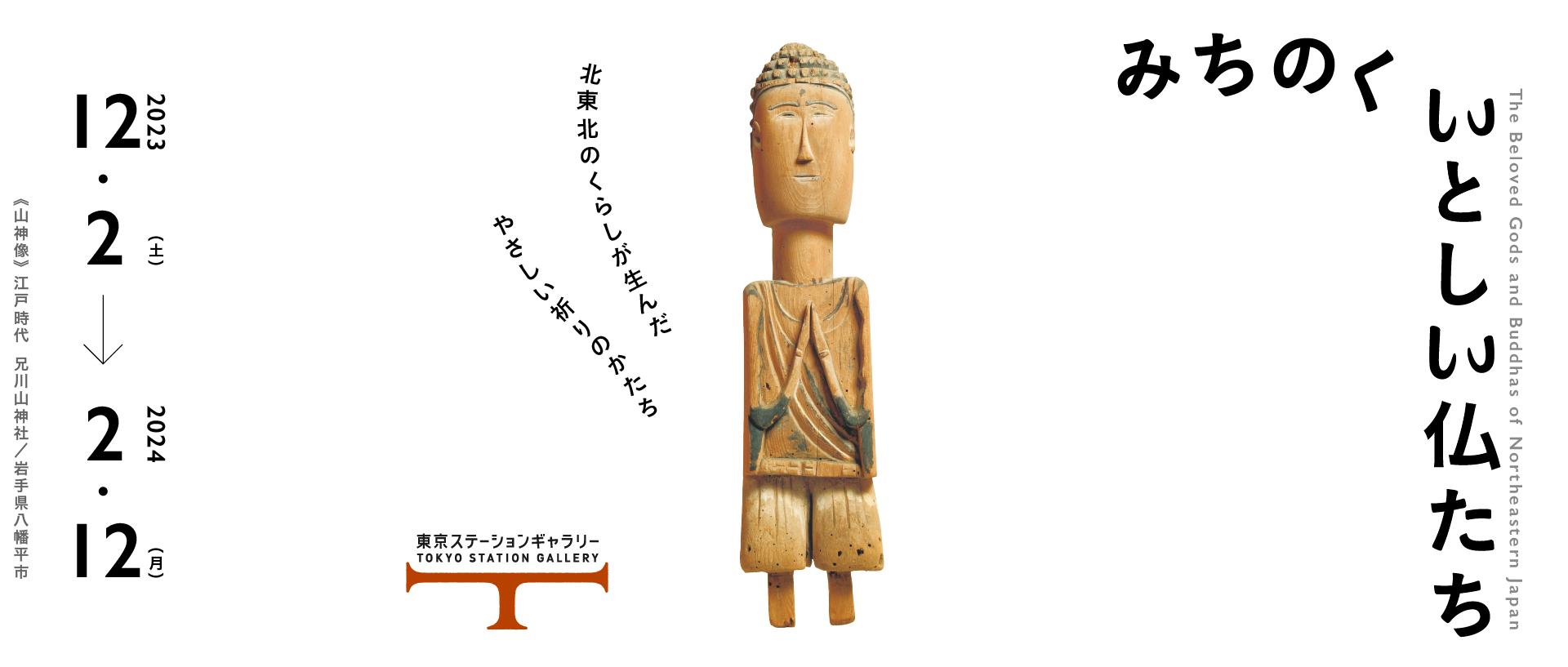
The Beloved Gods and Buddhas of Northeastern Japan
Saturday, December 2, 2023 - Monday, February 12, 2024
- Closed
- Mondays (except January 8, February 5 and February 12), December 29 – January 1, January 9
- Hours
- 10:00 am to 6:00 pm (8:00 pm on Fridays)
Last admission is 30 minutes before closing time.
Exhibition Overview
A Gentle Form of Prayer Shaped by Lifestyles in the Northeastern Region of Japan
During the Edo period (17-mid-19th c.), the shape and solemnity of the main halls of temples were standardized, and splendid Buddhist statues made in Kamigata (Kyoto) and Edo (now Tokyo) were enshrined as the principal image in temples throughout Japan. On the other hand, in local villages, simple and unique statues of Buddha and deities were enshrined in small halls and shrines. These folk Buddhas were carved not by Buddhist priests but by carpenters. Unlike the main image, which has a neat face and figure, these statues are not decorated with glittering ornaments. Their poor carvings and awkward proportions are not only unique, but also reflect the sentiments and prayers of the people of Michinoku, who live in the harsh climate of the region. This exhibition introduces approximately 130 wooden statues, full of individuality, that have listened to the concerns and prayers of the northern Tohoku region of Aomori, Iwate, and Akita. It provides an opportunity to think about the form of Japanese faith.
Highlights
Guardian Deity of the Mountain, Anigawayamakamisha / Hachimantai-shi, Iwate
This mountain god is still revered by people involved in the forestry industry. His large face, slightly protruding eyes and nose, narrow shoulders, and very modest pose with his palms together make him an appropriate main visual for this exhibition. The round head and square bento box-like upper body are a perfect match.
Demon, Shōfukuji / Kuzumaki-machi, Iwate
A demon, who torments the deceased in hell for their sins, is posed with a woman in his left hand, looking very pleased with himself. The demon is wearing a headscarf, but his large ears are not fully concealed, and even the hair on his chest, belly button, and shins is comically depicted. Demons associated with hell are meant to warn people against sinful behavior, but the fact that they are depicted in such an amusing manner may reflect a wish to laugh off the hardships of this life.
Standing Roku Kannon Bosatsu (Six Manifestations of Avalokitesvara), Houshakuji / Kuzumaki-machi, Iwate
The simple face carved from high-quality katsura wood contrasts with the elaborate folds of the robe. The six Avalokitesvara Kannon statues (Shō-Kannon, Senju-Kannon, Batō-Kannon, Jūichimen-Kannon, Juntei-Kannon, and Nyoirin-Kannon), which are thought to have been created for some memorial service, are superbly sculpted with the serenity of prayer and ornamentation.
Standing Fudō Myōō (Acalanatha) and Two Children Attendants, Tōenji / Takko-machi, Aomori
The mischievous-looking Seitaka-doji (left), with his bulging muscles, and the plump, smiling Kongara-doji (right), with his gentle smile, stand on either side of the hip-twisted Fudō Myoō. They appear to be a unique trio from a mountainous region.
Seated Avalokitesvara Holding a Child, Jigenji / Goshogawara-shi, Aomori
Is it the mother's feelings for the little life she could not save, or the grief of the family who lost both mother and child, that is reflected in this statue? The poorly expressed hand holding the baby firmly in its arms may express straightforward and earnest prayer.
Kneeling Youthful Deity (The Repentant Dead) by Emonshirō, Hōrenji / Towada-shi, Aomori
The rounded bottom of the statue is designed to swing back and forth, overlapping the image of a child repeatedly apologizing to demons and ten kings in hell, or a child piling up stones on the riverbank of the Sai no Kawara. There are many such statues in Towada, both martial and gentle, carved by the carpenter Emonshirō.
Information
- Admission Fees
-
Adults: 1,400 (1,200) yen, High school and University students: 1,200 (1,000) yen
Junior high-school students and younger: Free- *Prices in ( ) indicate the advance ticket prices.
- *Advance tickets are available online from November 1 to December 1, 2023.
- *Persons with disability certificate or similar receive a 100 yen discount, and one accompanying helper is admitted free.
- *Students must present student ID upon entrance to the museum.
- Ticketing
-
Where to Buy Tickets:
- ・At Online
- ・At the Entrance of Tokyo Station Gallery
- *Please purchase tickets online in advance to ensure smooth entry.
- *Please purchase tickets at the museum if you wish to receive a discount by presenting a coupon or membership card. Please note that you may be asked to wait to enter during congested times.
- Organized by
- Tokyo Station Gallery [East Japan Railway Culture Foundation], NHK, NHK Promotions Inc.
- With the sponsorship of
- T&D Insurance Group
- Supervised by
- Hirotoshi Sudo (Professor Emeritus, Hirosaki University)
